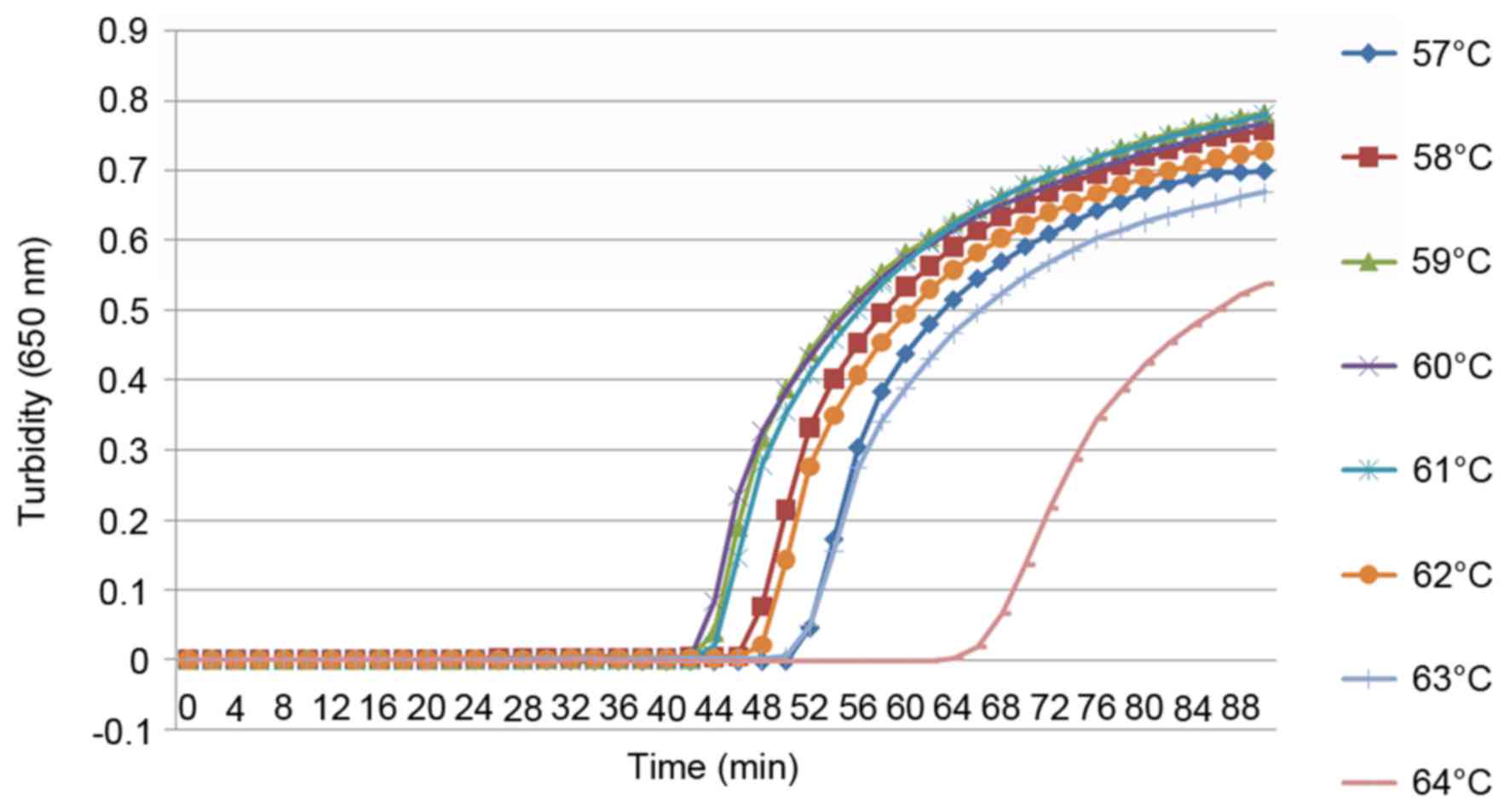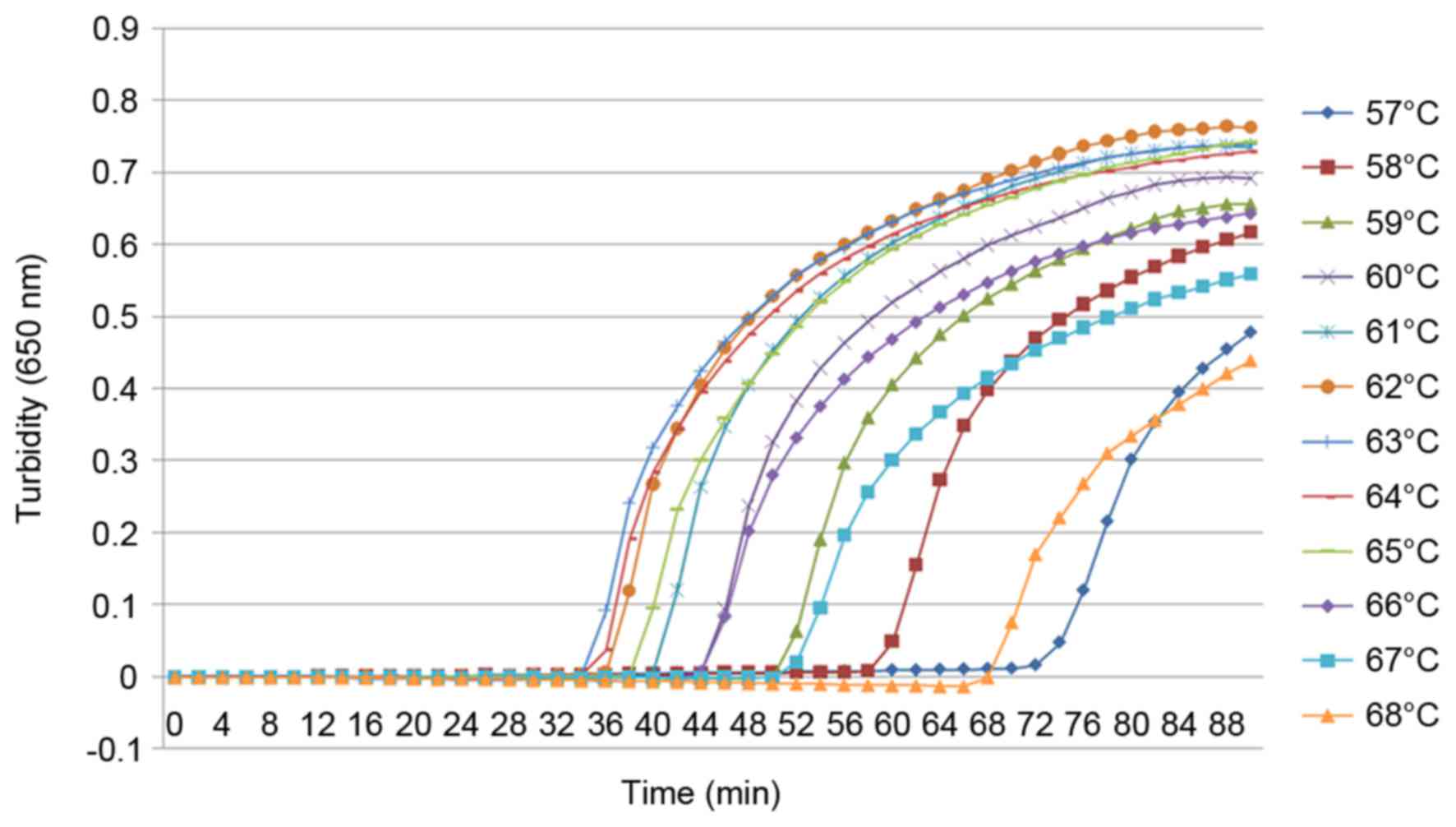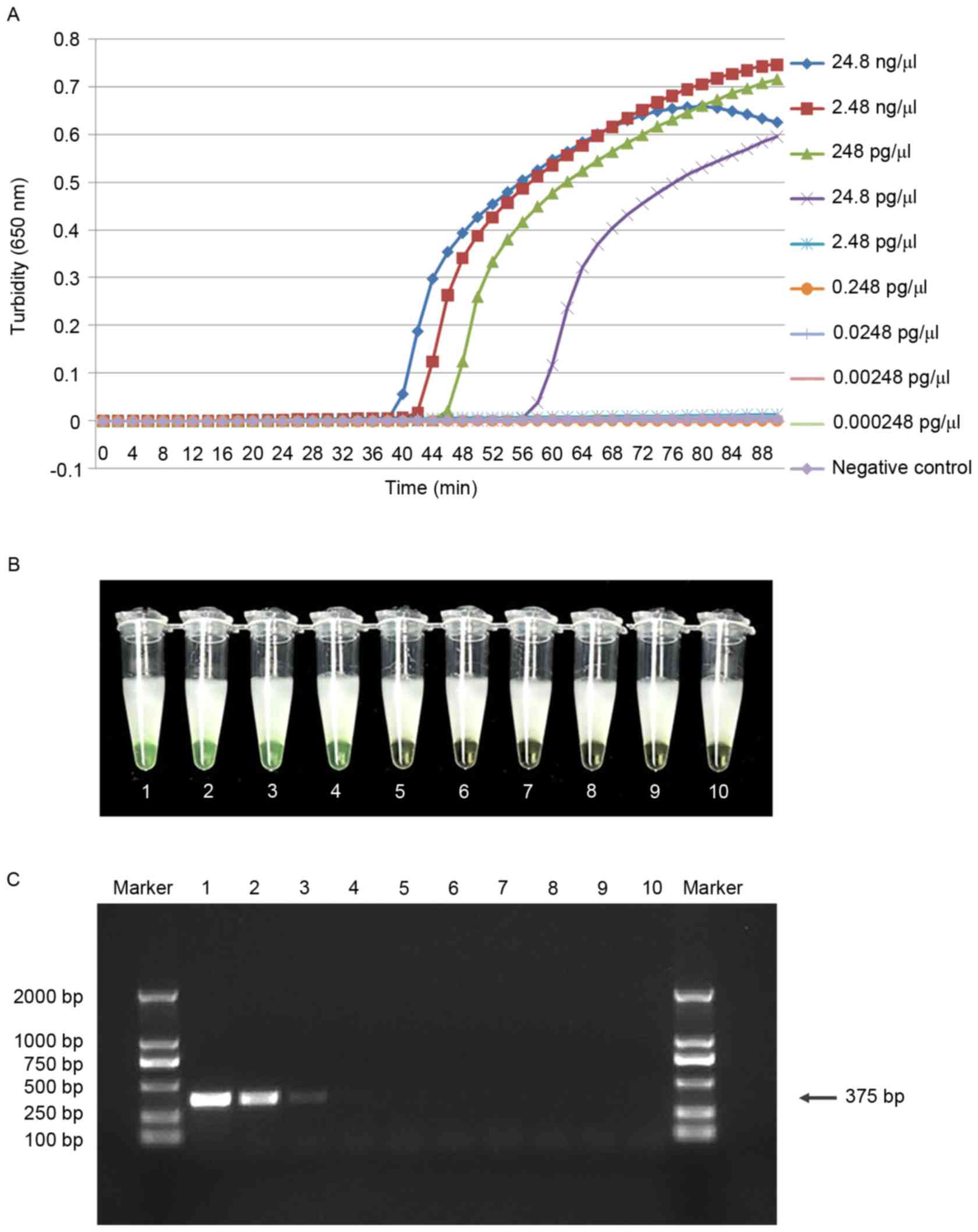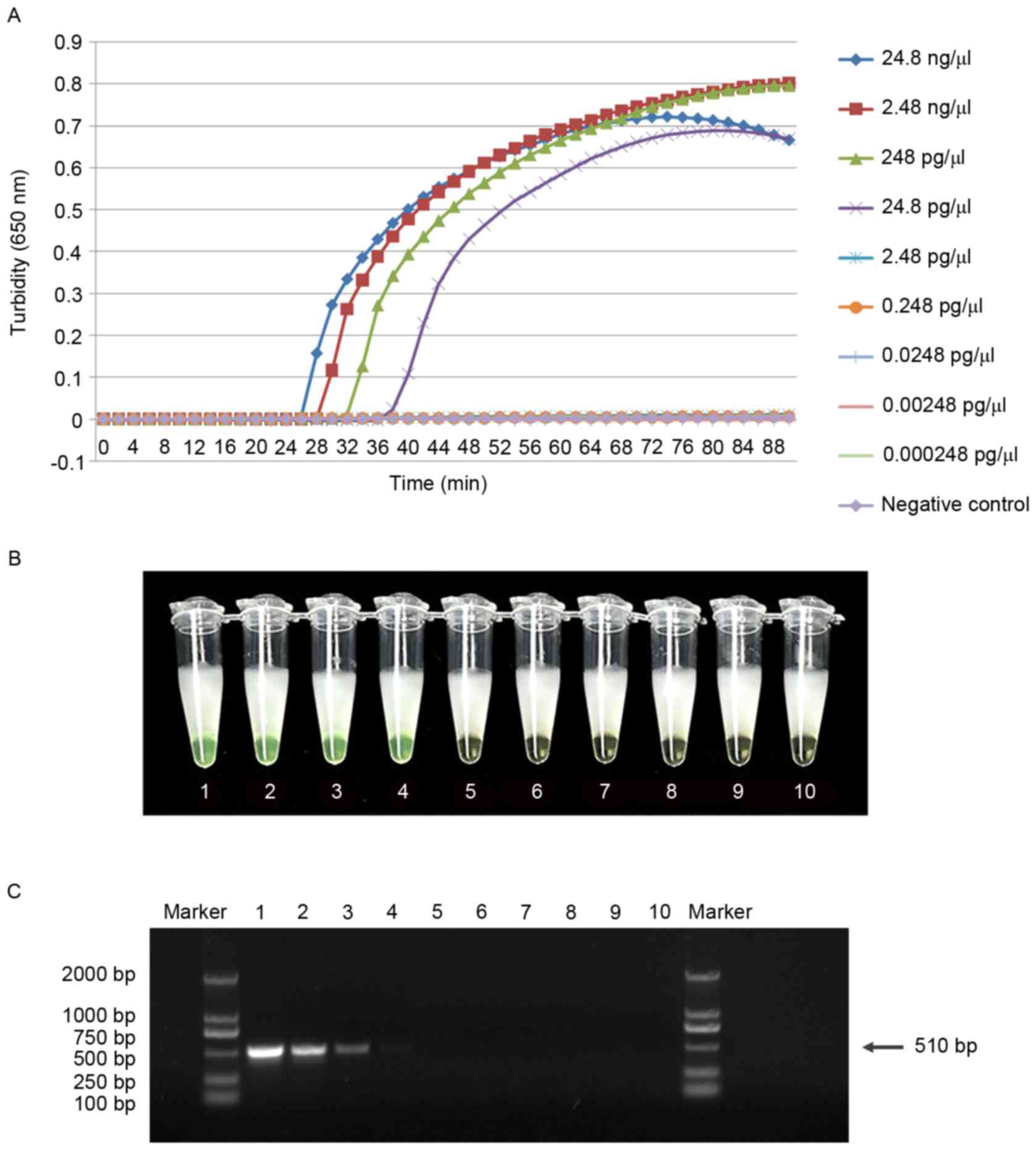Introduction
Clostridium difficile is a gram-positive
toxin-producing bacillus that causes intestinal infections in
humans and animals (1). C.
difficile presents an emerging threat in hospital environments
(2), causing a range of digestive
disorders, including inflammation of the bowel, abdominal pain,
fever and diarrhea (1). C.
difficile infection has increased in prevalence and severity
over the last decade (2,3). Its pathogenesis comes from its ability
to release two different toxins; toxins A and B. These toxins
glucosylate and inactivate the Rho factor proteins of host cells.
In addition, certain C. difficile isolates produce the
binary toxin C. difficile transferase (CDT) (1,4,5). CDT belongs to the family of binary
adenosine diphosphate (ADP)-ribosylating toxins and is made up of
two separate toxin components: i) The enzymatic
ADP-ribosyltransferase that modifies actin (CDTa); and ii) CDTb
that binds to host cells and translocates CDTa into the cytosol
(6). These two independent, unlinked
protein chains are encoded by two separate genes, designated
cdtA and cdtB (1,5,7). CDT serves an important role in the
immediate colonization of C. difficile; it can create thin
microtubule protrusions on the surface of intestinal epithelial
cells, which increase the adherence of C. difficile onto the
surface of these cells (4). CDT
positive strains were previously reported as an infrequent cause of
C. difficile infection in human populations but have become
increasingly prevalent over the past decade (6). CDT is an important contributing factor
towards the pathogenesis of C. difficile, and CDT-producing
C. difficile infections are known to be more severe and have
higher fatality rates than those caused by CDT-negative isolates
(4). This has lead to CDT being
viewed as a serious health threat (1).
The accurate and rapid diagnostic testing for
CDT-producing C. difficile is essential for patient
management and the timely implementation of infection control
measures; however, sensitive and specific diagnostic tests for CDT
detection are lacking (3). Advances
in molecular methods for the detection of pathogens may offer
increased sensitivity and specificity. For example, the binary
toxin CDT encoding genes cdtA and cdtB are potential
biomarkers for diagnostic purposes (3).
In the present study, a low-complexity method for
the detection of binary toxin-producing C. difficile, that
makes use of loop-mediated isothermal amplification (LAMP) was
used. LAMP is a nucleic acid detection technique first described in
2,000, which commands high specificity as the amplification of DNA
is conducted by two to three pairs of primers recognizing six
independent regions on a target gene (8). LAMP was developed to amplify target DNA
without the temperature shifts normally required for denaturing,
annealing, and extension during the polymerase chain reaction (PCR)
(9). As this method proceeds at a
constant temperature, requiring only a thermostat, it can be
effectively performed in the field. In the present study, the CDT
encoding genes cdtA and cdtB were used for the
diagnosis of CDT-producing C. difficile using LAMP (10). Although LAMP has previously been
applied to detect the C. difficile enterotoxin A encoding
gene tcdA and the cytotoxin B encoding gene tcdB
(2,3,11,12),
electrophoresis or other sophisticated apparatus, such as a
real-time turbidimeter, were still required for the determination
of the amplified products. The present study describes a visual
detection method based on a color change in the
calcein/Mn2+ mixture, allowing immediate interpretation
of the LAMP results by the naked eye. This newly developed visual
LAMP assay is simple, fast and only requires thermostatic
equipment.
Materials and methods
Collection of clinical samples
A total of 10 stool samples were collected from
hospitalized patients in the Infection Control and Hospital
Epidemiology (Beijing, China). Written informed consent was
obtained from all patients prior to sample collection. Of the 10
C. difficile strains that tested positive for binary toxin
genes, only 1 strain that was isolated from a patient with Crohn's
disease was identified to be positive for the cdtA and cdtB genes
by LAMP detection. This was consistent with the results of
polymerase chain reaction (PCR) analysis.
Pathogen strains and DNA
extraction
A total of 25 strains used in the present study are
from our microorganism center (Institute of Disease Control and
Prevention, Academy of Military Medical Sciences; Beijing, China).
These strains included Bacillus megaterium, Vibrio
piscium, Pseudomonas maltophilia, Mycobacterium
tuberculosis 4368, Vibrio cholera O139, Bacillus
anthracis, enterohemorrhagic Escherichia coli,
Yersinia enterocolitica, Vibrio parahaemolyticus
(5474), Enteropathic Escherichia coli, enteroadherent
Escherichia coli, Enteroinvasive Escherichia coli,
Enterotoxigenic Escherichia coli, Yersinia pestis,
Streptococcus pneumoniae, Neisseria meningitides
group B CMCC29022, Burkholderia pseudomallei, Methicillin
resistant Staphylococcus aureus, Acinetobacter
baumannii, Escherichia coli, Bordetella pertussis
ATCC18530, Haemophilus influenzae, Corynebacterium
diphtheriae CMCC38001, Mycobacterium tuberculosis 4368
and Neisseria meningitides (NM29019). In addition, C.
difficile strains were cultured in a cycloserine cefoxitin
fructose agar base (BD Biosciences, Franklin Lakes, NJ, USA);
Mycobacterium tuberculosis, Vibrio parahaemolyticus
(5474), Neisseria meningitides and Haemophilus
influenzae were cultured in Chocolate Agar Plates (Beijing Land
Bridge Biotechnology Co., Ltd., Beijing, China); and other strains
were cultured in Brain Heart Infusion (BD Biosciences). The genomic
DNA of all strains was extracted using the TIANamp Bacteria DNA kit
(Tiangen Biotech Co., Ltd., Beijing, China) following the
manufactureri's instructions.
Primer design
The sequences of the cdtA and cdtB
genes, with the accession numbers HQ639673.1 and HQ639677.1
respectively, were retrieved from the NCBI GenBank database
(https://www.ncbi.nlm.nih.gov/genbank). Primer Explorer
Version 4 (primerexplorer.jp/elamp4.0.0/index.html; Fujitsu Ltd.,
Tokyo, Japan) was used to analyze the sequences, and design 8
primers for cdtA and 6 for cdtB. The primers were synthesized
commercially by Sangon Biotech Co., Ltd. (Shanghai, China) and
their sequences are presented in Table
I.
 | Table I.Sequences of the primers used for the
specific amplification of cdtA and cdtB. |
Table I.
Sequences of the primers used for the
specific amplification of cdtA and cdtB.
| A, cdtA
primers |
|---|
|
|---|
| Primer type | Reaction used
in | Sequence
(5′-3′) |
|---|
| F3 | LAMP |
TCTGGTCCTCAAGAATTTGG |
| B3 | LAMP |
AATAGCTGATAGATAAGCTCCA |
| FIP | LAMP |
GCTTGTCCTTCCCATTTTGATTTAATTTTTAACTCTTACTTCCCCTGA |
| BIP | LAMP |
ATTGGTAGTGTGAATATGAGTGCATTACCTTTAGGTATAGTTATACGTAGT |
| LF | LAMP |
AAATCATATTCAGGGGAA |
| LB | LAMP |
TTTGCTAAAAGAAAAATAGTACTAC |
| F | PCR |
TGAACCTGGAAAAGGTGATG |
| B | PCR |
AGGATTATTTACTGGACCATTTG |
|
| B, cdtB
primers |
|
| Primer type | Reaction used
in | Sequence
(5′-3′) |
|
| F3 | LAMP |
GAGTCAAATACTGCTGGAGA |
| B3 | LAMP |
TAGTAGCTCTGGAAACAGTT |
| FIP | LAMP |
CGGATCTCTTGCTTCAGTCTTTTTTCAGATTATGAAAAAGCTTCAGGTT |
| BIP | LAMP |
AGTTGCAGCATATCCAATTGTTGGTTTCCTTGATCAGTAGAGGCATG |
| F | PCR |
CTTAATGCAAGTAAATACTGAG |
| B | PCR |
AACGGATCTCTTGCTTCAGTC |
LAMP assay
A LAMP assay was performed using a Loopamp DNA
Amplification kit (Eiken Chemical Co., Ltd., Tochigi, Japan)
according to the manufacturer's protocol.
LAMP assay product detection
The amplification products were detected using two
methods; a real-time turbidimeter (La-320C; Eiken Chemical Co.,
Ltd.) at 650 nm and visual observation. Pyrophosphate ions are
released during the LAMP reaction process and they form a white
magnesium phosphate precipitate. This can be monitored using a
real-time turbidimeter, drawing reaction curves every 6 sec with
Mg2+ ions in the reaction buffer (13). For visual detection, 1 µl of Loopamp
Fluorescent Detection reagent (Eiken Chemical Co., Ltd.),
containing a metal indicator, was added into the reaction system
prior to amplification. The reaction buffer initially turned orange
because the calcein was quenched by Mn2+ ions. Then,
during amplification the calcein was displaced by pyrophosphate
ions from the calcein/Mn2+ complex, and the color
changed from orange to green. By contrast, if no amplification
occurred, no color change was observed.
PCR analysis
To assess the detection limit of LAMP compared with
traditional PCR, genomic DNA extracted from C. difficile was
serially diluted at a ratio of 1:10 (from 24.8 ng/µl to 0.000248
pg/µl) and tested using the real-time turbidity monitor, the visual
method and using the GeneAmp® PCR system 9700 (Thermo
Fisher Scientific, Inc., Waltham, MA, USA). The reaction mixture
for PCR contained 12.5 µl 2X Taq PCR Master Mix (Tiangen Biotech
Co., Ltd.), 1 µl of each primer, 1 µl genomic DNA as a template and
ddH2O to a final volume of 25 µl. The thermocycling
conditions for PCR were as follows: 95°C for 5 min; followed by 30
cycles of 95°C for 30 sec 60°C for 5 min and 95°C for 5 min; and
then a final extension step at 72°C for 7 min. For detection of the
PCR products, a 1% agarose gel containing ethidium bromide was
used. The marker used was DL2000 (Takara Biotechnology, Dalian,
China). C. difficile was used as a positive control,
ddH2O as the negative control and 25 different strains
of pathogen (listed above) were used as test strains.
Results
Optimal conditions for the
simultaneous detection of cdtA and cdtB
To the best of our knowledge, the present study was
the first to use the cdtA and cdtB genes as the
target sequences for a LAMP assay detecting C. difficile.
For this reason it was necessary to establish the optimal
conditions for the reaction. Six and four primers were designed for
the detection of the cdtA and cdtB genes,
respectively, using the same reaction conditions. Using a real-time
turbidimeter, turbidity curves at 650 nm were constructed according
to the amplification data. To optimize the reaction conditions for
the LAMP assay, different reaction temperatures from 57–68°C were
analyzed using the real-time tubidimeter (Figs. 1 and 2). When detecting cdtA, the optimal
conditions were 59, 60 and 61°C for 60 min; however, for the
detection of cdtB, the optimal conditions were 60°C for 60 min.
Therefore, for the detection of cdtA and cdtB, the
optimal conditions were set at 60°C for 60 min.
Specificity of the LAMP assay to C.
difficile
To evaluate the specificity of LAMP detection for
cdtA and cdtB, genomic DNA extracted from C.
difficile was used as a positive control, ddH2O as
the negative control and 25 different strains of pathogen were used
as test strains. The two detection methods gave the same results
and no reactivity was recorded with any other pathogenic bacterial
strains or the negative control (Figs.
3 and 4). This demonstrates that
the LAMP assay used in the present study is specific to C.
difficile.
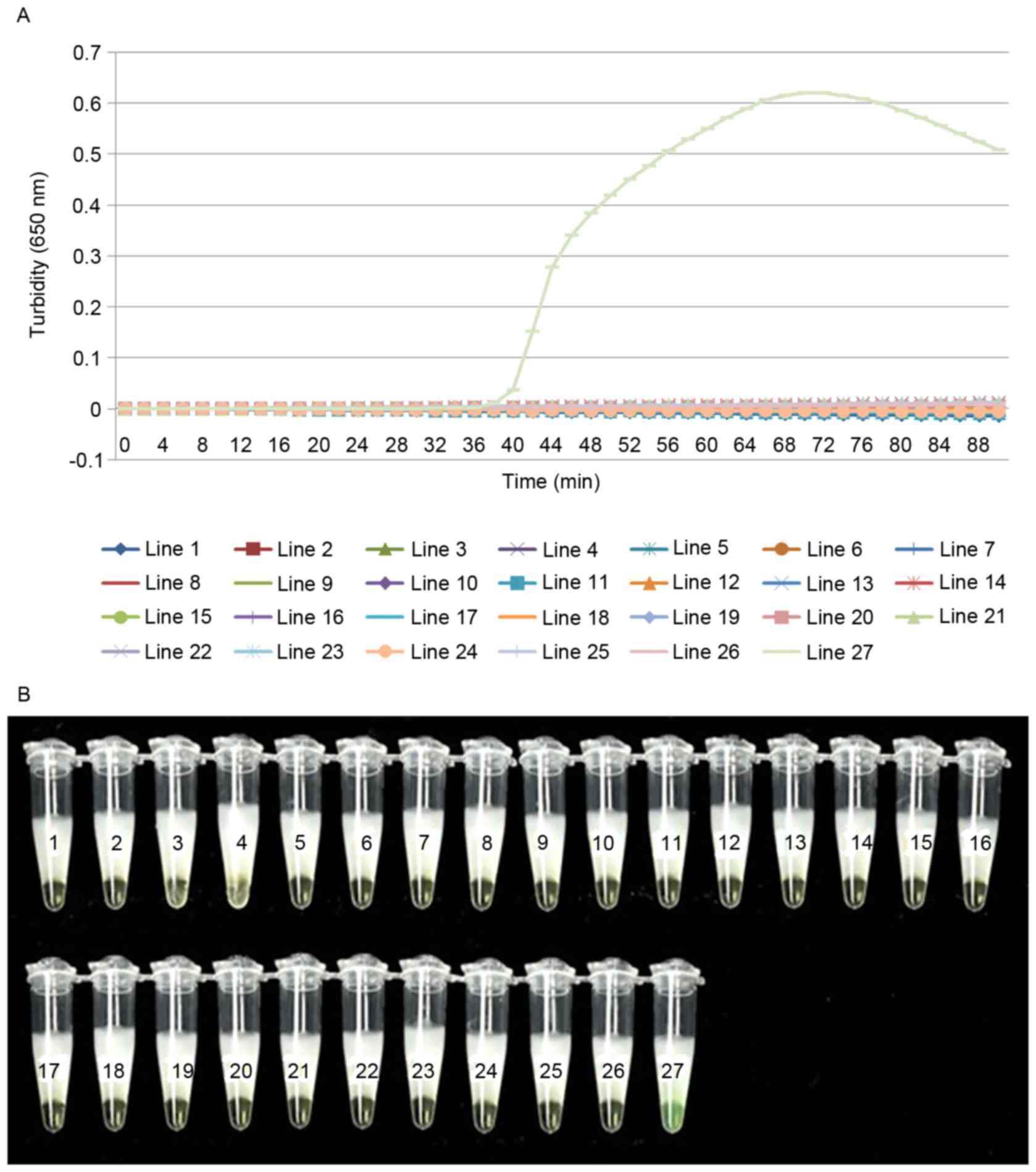 | Figure 3.LAMP of cdtA has a high degree
of specificity. Determination of the specificity of cdtA
detection of the LAMP assay by (A) real-time turbidimeter or (B)
visual detection after the addition of calcein to the reaction
system. Amplification was performed at 60°C for 60 min. 1,
Bacillus megaterium; 2, Vibrio piscium; 3,
Pseudomonas maltophilia; 4, Mycobacterium
tuberculosis 4368; 5, Vibrio cholera O139; 6,
Bacillus anthracis; 7, enterohemorrhagic Escherichia
coli; 8, Yersinia enterocolitica; 9, Vibrio
parahaemolyticus (5474); 10, Enteropathic Escherichia
coli; 11, enteroadherent Escherichia coli; 12,
Enteroinvasive Escherichia coli; 13, Enterotoxigenic
Escherichia coli; 14, Yersinia pestis; 15,
Streptococcus pneumoniae; 16, Neisseria meningitides
group B CMCC29022; 17, Burkholderia pseudomallei; 18,
Methicillin resistant Staphylococcus aureus; 19,
Acinetobacter baumannii; 20, Escherichia coli; 21,
Bordetella pertussis ATCC18530; 22, Haemophilus
influenzae; 23, Corynebacterium diphtheriae CMCC38001;
24, Mycobacterium tuberculosis 4368; 25, Neisseria
meningitides (NM29019); 26, negative control; 27, positive
control; LAMP, loop-mediated isothermal amplification; cdt,
Clostridium difficile transferase. |
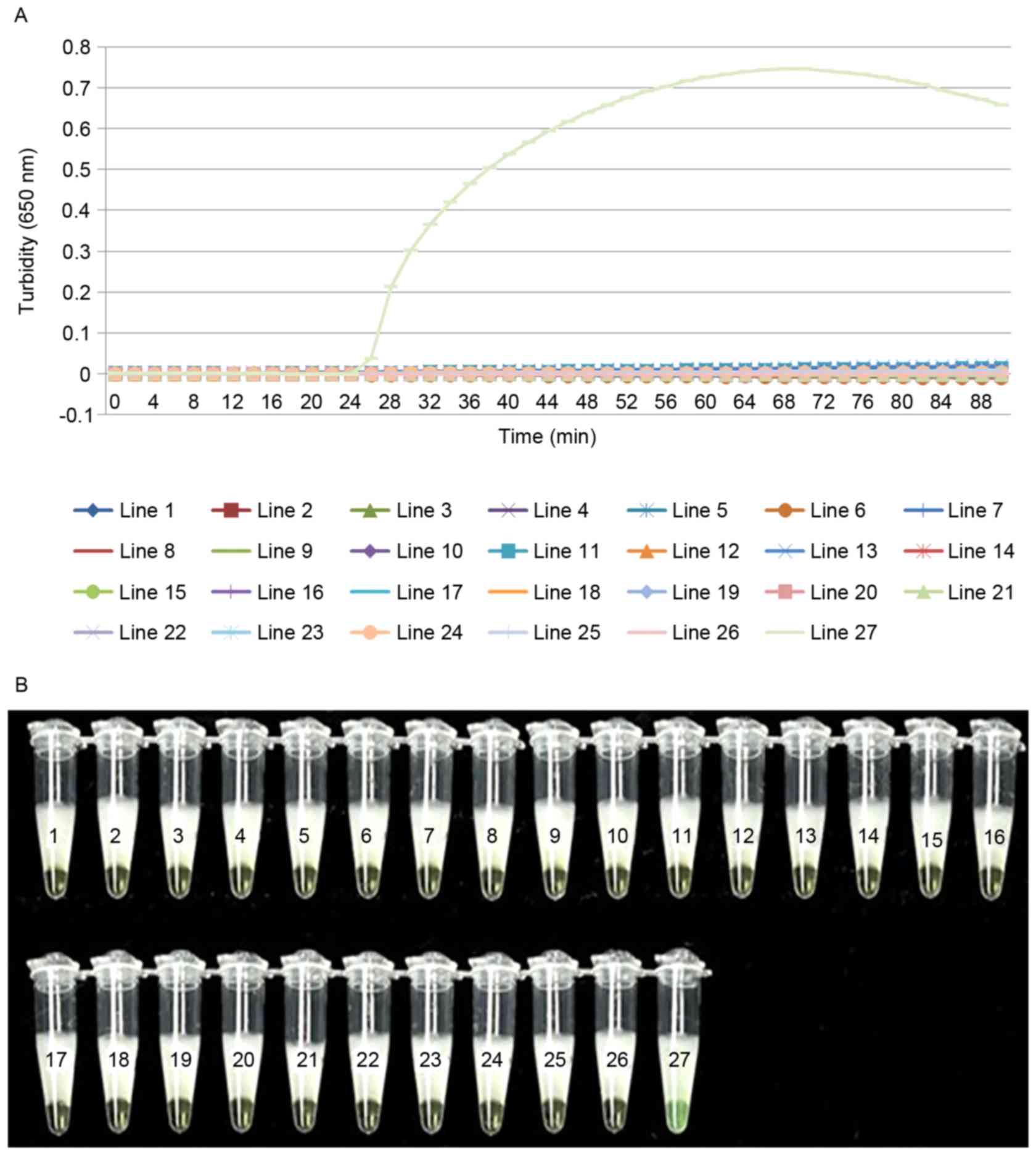 | Figure 4.LAMP of cdtB has a high degree
of specificity. Determination of the specificity of cdtB
detection of the LAMP assay by (A) real-time turbidimeter or (B)
visual detection after the addition of calcein to the reaction
system. Amplification was performed at 60°C for 60 min. 1,
Bacillus megaterium; 2, Vibrio piscium; 3,
Pseudomonas maltophilia; 4, Mycobacterium
tuberculosis4368; 5, Vibrio cholera O139; 6, Bacillus
anthracis; 7, enterohemorrhagic Escherichia coli; 8,
Yersinia enterocolitica; 9, Vibrio parahaemolyticus
(5474); 10, enteropathic Escherichia. coli; 11,
enteroadherent Escherichia coli; 12, enteroinvasive
Escherichia coli; 13, enterotoxigenic Escherichia
coli; 14, Yersinia pestis; 15, Streptococcus
pneumoniae; 16, Neisseria meningitides group B
CMCC29022; 17, Burkholderia pseudomallei; 18, Methicillin
resistant Staphylococcus aureus; 19, Acinetobacter
baumannii; 20, Escherichia coli; 21, Bordetella
pertussis ATCC18530; 22, Haemophilus influenzae; 23,
Corynebacterium diphtheriae CMCC38001; 24, Mycobacterium
tuberculosis 4368; 25, Neisseria meningitides (NM29019);
26, negative control; 27, positive control; LAMP, loop-mediated
isothermal amplification; cdt, Clostridium difficile
transferase. |
LAMP has a higher sensitivity in the
detection of C. difficile compared with PCR
Serial dilutions of genomic DNA were tested using
the real-time turbidity monitor, the visual method and PCR. The
limit of detection for cdtA and cdtB was 24.8 pg/µl
using the visual method and the real-time turbidimeter, which was
10-fold higher than that of the traditional PCR assay (Figs. 5 and 6). This suggests that the LAMP assay is
more sensitive than traditional PCR for the detection of C.
difficile. In addition, the minimum detectable concentration
reaction time was within 60 min. To avoid non-specific
amplification, the response time was limited to 60 min.
Discussion
C. difficile is the most prevalent cause of
healthcare-associated infectious diarrhea (14). Infection due to CDT-producing strains
of C. difficile has been correlated with higher mortality
rates compared to CDT negative strain infections (4). A previous study has suggested an
association between the presence of CDT in infectious C.
difficile strains and the increased mortality of patients
(6). In infections due to CDT
positive strains, abdominal pain and diarrhea were also reported to
be more severe (4). As such, rapid
and sensitive laboratory diagnostic testing for CDT positive
strains of C. difficile is highly desirable. Diagnostic
testing for toxigenic C. difficile has traditionally been
accomplished by time-consuming culture methods and by immunoassays,
which are faster but in general do not have sufficient sensitivity.
Immunoassays that detect the glutamate dehydrogenase antigen
display high sensitivity but poor specificity for C.
difficile (15). By comparison,
molecular tests have increased sensitivity and specificity
(16). To the best of our knowledge,
there have been no studies on the detection of CDT encoded genes.
The present study investigated the efficacy of LAMP to directly
detect the cdtA and cdtB genes in order to aid in the
diagnosis of binary toxin-associated C. difficile infection.
The cdtA and cdtB genes were targeted by specific
primer sets in this molecular-based assay with rapid turnaround
times. Although this method has been applied for the detection and
identification of other microbial pathogens (17), to the best of our knowledge this is
the first time this technique has been applied to detect CDT
positive C. difficile. The LAMP assay does not require
skilled operators or precise instruments, and is therefore
practically applicable within point of care settings with poor
resources. Since its introduction by Notomi et al (8) in 2000, it has been widely applied to a
variety of fields, including clinical diagnosis, food safety,
livestock breeding and determination of sex (18,19).
This is largely due to its rapid and simple methodology. Numerous
reports have demonstrated that LAMP offers high sensitivity and
specificity for the detection of pathogens (20,21).
The present study investigated a visual LAMP method
for detecting the cdtA and cdtB genes of C.
difficile. The specificity of this assay was confirmed by
testing strains of 26 bacterial species, including C.
difficile, using a real-time turbidimeter and visual methods. A
positive result was only obtained for C. difficile, all
other species gave a negative result. This confirmed the
specificity of the assay for detecting C. difficile, and
indicated that the turbidimeter and visual detection methods
exhibited the same level of specificity. The sensitivity of the
LAMP assay for detecting the cdtA and cdtB genes was
tested using a 10-fold serial dilution of pure genomic DNA
extracted from C. difficile. Consistent with previous
reports, LAMP was identified to be 10-fold more sensitive than PCR
analysis, with a detection limit of 24.8 pg/µl for the real-time
turbidimeter and visual methods. Furthermore, the LAMP assay was
completed within 1.5 h using a simple thermostat, whereas PCR took
3 h and required a specialized thermocycler. The LAMP assay offers
a simpler method and a faster result, and is therefore preferential
for urgent diagnosis in the field.
In conclusion, the visual LAMP assay developed for
detecting CDT positive C. difficile strains in the present
study has a number of advantages over regular PCR amplification,
such as the ability for results to be observed with the naked eye
immediately after amplification is complete. The LAMP assay is also
more sensitive than PCR in detecting CDT positive C.
difficile. The results obtained with this visual method were
consistent with the real-time turbidimeter observations.
Consequently, this procedure offers a faster, simpler, more
sensitive and lower cost method for diagnosing CDT-producing C.
difficile, which may be particularly useful within point of
care settings. No rapid diagnostic tool is available for detecting
CDT-producing C. difficile at present, and this assay could
be a useful and reliable diagnostic tool for infection control in
clinical settings, even those lacking a clinical microbiology
laboratory. Rapid diagnosis can be crucial during an infection
outbreak and may potentially decrease the nosocomial transmission,
morbidity and mortality associated with C. difficile
infection.
Acknowledgements
The present study was supported by the Innovation
and Development Fund of the Navy General Hospital (Beijing, China;
grant no. KT-0821).
References
|
1
|
Doosti A and Mokhtari-Farsani A: Study of
the frequency of Clostridium difficile tcdA, tcdB, cdtA and cdtB
genes in feces of Calves in south west of Iran. Ann Clin Microbiol
Antimicrob. 13:212014. View Article : Google Scholar : PubMed/NCBI
|
|
2
|
Norén T, Unemo M, Magnusson C, Eiserman M
and Matussek A: Evaluation of the rapid loop-mediated isothermal
amplification assay Illumigene for diagnosis of Clostridium
difficile in an outbreak situation. APMIS. 122:155–160. 2014.
View Article : Google Scholar : PubMed/NCBI
|
|
3
|
Boyanton BL Jr, Sural P, Loomis CR, Pesta
C, Gonzalez-Krellwitz L, Robinson-Dunn B and Riska P: Loop-mediated
isothermal amplification compared to real-time PCR and enzyme
immunoassay for toxigenic Clostridium difficile detection. J Clin
Microbiol. 50:640–645. 2012. View Article : Google Scholar : PubMed/NCBI
|
|
4
|
Kim J, Seo MR, Kang JO, Choi TY and Pai H:
Clinical and Microbiologic characteristics of Clostridium difficile
infection caused by binary toxin producing strain in Korea. Infect
Chemother. 45:175–183. 2013. View Article : Google Scholar : PubMed/NCBI
|
|
5
|
Papatheodorou P, Hornuss D, Nölke T,
Hemmasi S, Castonguay J, Picchianti M and Aktories K: Clostridium
difficile binary toxin CDT induces clustering of the
lipolysis-stimulated lipoprotein receptor into lipid rafts. MBio.
4:e00244–e00213. 2013. View Article : Google Scholar : PubMed/NCBI
|
|
6
|
Gerding DN, Johnson S, Rupnik M and
Aktories K: Clostridium difficile binary toxin CDT: Mechanism,
epidemiology, and potential clinical importance. Gut Microbes.
5:15–27. 2014. View Article : Google Scholar : PubMed/NCBI
|
|
7
|
Silva RO, Santos RL, Pires PS, Pereira LC,
Pereira ST, Duarte MC, de Assis RA and Lobato FC: Detection of
toxins A/B and isolation of Clostridium difficile and Clostridium
perfringens from dogs in Minas Gerais, Brazil. Braz J Microbiol.
44:133–137. 2013. View Article : Google Scholar : PubMed/NCBI
|
|
8
|
Notomi T, Okayama H, Masubuchi H, Yonekawa
T, Watanabe K, Amino N and Hase T: Loop-mediated isothermal
amplification of DNA. Nucleic Acids Res. 28:E632000. View Article : Google Scholar : PubMed/NCBI
|
|
9
|
Kim JB, Han AR, Park EY, Kim JY, Cho W,
Lee J, Seo EK and Lee KT: Inhibition of LPS-induced iNOS, COX-2 and
cytokines expression by poncirin through the NF-kappaB inactivation
in RAW 264.7 macrophage cells. Biol Pharm Bull. 30:2345–2351. 2007.
View Article : Google Scholar : PubMed/NCBI
|
|
10
|
Hori S, Nomura T and Sakaguchi S: Control
of regulatory T cell development by the transcription factor Foxp3.
Science. 299:1057–1061. 2003. View Article : Google Scholar : PubMed/NCBI
|
|
11
|
Gandelman O, Jackson R, Kiddle G and Tisi
L: Loop-mediated amplification accelerated by stem primers. Int J
Mol Sci. 12:9108–9124. 2011. View Article : Google Scholar : PubMed/NCBI
|
|
12
|
Liu C, Jiang DN, Xiang GM, Luo FK, Liu LL,
Yu JC and Pu XY: DNA detection of Clostridium difficile infection
based on real-time resistance measurement. Genet Mol Res.
12:3296–3304. 2013. View Article : Google Scholar : PubMed/NCBI
|
|
13
|
Mori Y, Nagamine K, Tomita N and Notomi T:
Detection of loop-mediated isothermal amplification reaction by
turbidity derived from magnesium pyrophosphate formation. Biochem
Biophys Res Commun. 289:150–154. 2001. View Article : Google Scholar : PubMed/NCBI
|
|
14
|
Gavin MA, Rasmussen JP, Fontenot JD, Vasta
V, Manganiello VC, Beavo JA and Rudensky AY: Foxp3-dependent
programme of regulatory T-cell differentiation. Nature.
445:771–775. 2007. View Article : Google Scholar : PubMed/NCBI
|
|
15
|
Pollock NR: Ultrasensitive detection and
quantification of toxins for optimized diagnosis of Clostridium
difficile infection. J Clin Microbiol. 54:259–264. 2016. View Article : Google Scholar : PubMed/NCBI
|
|
16
|
Hicke B, Pasko C, Groves B, Ager E, Corpuz
M, Frech G, Munns D, Smith W, Warcup A, Denys G, et al: Automated
detection of toxigenic Clostridium difficile in clinical samples:
Isothermal tcdB amplification coupled to array-based detection. J
Clin Microbiol. 50:2681–2687. 2012. View Article : Google Scholar : PubMed/NCBI
|
|
17
|
Mansour SM, Ali H, Chase CC and Cepica A:
Loop-mediated isothermal amplification for diagnosis of 18 World
Organization for Animal Health (OIE) notifiable viral diseases of
ruminants, swine and poultry. Anim Health Res Rev. 16:89–106. 2015.
View Article : Google Scholar : PubMed/NCBI
|
|
18
|
Yang L, Li J, Bi Y, Xu L and Liu W:
Development and application of a reverse transcription
loop-mediated isothermal amplification method for rapid detection
of Duck hepatitis A virus type 1. Virus Genes. 45:585–589. 2012.
View Article : Google Scholar : PubMed/NCBI
|
|
19
|
Hirayama H, Kageyama S, Moriyasu S, Sawai
K and Minamihashi A: Embryo sexing and sex chromosomal chimerism
analysis by loop-mediated isothermal amplification in cattle and
water buffaloes. J Reprod Dev. 59:321–326. 2013. View Article : Google Scholar : PubMed/NCBI
|
|
20
|
Seki M, Yamashita Y, Torigoe H, Tsuda H,
Sato S and Maeno M: Loop-mediated isothermal amplification method
targeting the lytA gene for detection of Streptococcus pneumoniae.
J Clin Microbiol. 43:1581–1586. 2005. View Article : Google Scholar : PubMed/NCBI
|
|
21
|
Kim DW, Kilgore PE, Kim EJ, Kim SA, Anh
DD, Dong BQ, Kim JS and Seki M: The enhanced pneumococcal LAMP
assay: A clinical tool for the diagnosis of meningitis due to
Streptococcus pneumoniae. PLoS One. 7:e429542012. View Article : Google Scholar : PubMed/NCBI
|















